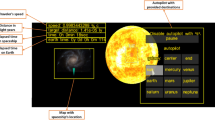Abstract
This chapter examines the effects of immersive virtual reality (VR) learning units on the learning success of secondary school students. In a three-step research approach an immersive VR prototype that was designed to achieve specific learning goals in the field of mathematics was developed and validated with pedagogues. In a second step the usability of this prototype was tested with 20 secondary school students. Finally, a field experiment was conducted with 67 secondary school students to evaluate the impact of the VR learning environment on the achievement of measurable learning goals. The analysis showed no difference in learning success between a conventional mathematics lesson and the VR learning environment. The subjects of both experimental group (with VR) and control group (conventional lesson) achieved short and medium-term learning success. Some tendencies with respect to differences by gender and by short- versus long-term learning success lack statistical relevance, but can be seen as indications for further research to investigate the potential of immersive learning.
Access this chapter
Tax calculation will be finalised at checkout
Purchases are for personal use only
Similar content being viewed by others
References
Affolter, W., & Walt, M. (2017). mathbuch IF: Begleitband für die integrative Förderung Klassen 7–9 (1. Auflage). Klett und Balmer Verlag.
Bloom, B. S., Krathwohl, D. R., & Masia, B. S. (1984). Taxonomy of educational objectives. The classification of educational goals: Cognitive domain handbook 1. New York: Longman.
Burdea, G., & Coiffet, P. (2003). Virtual reality technology (2nd ed.). Hoboken, NJ: J. Wiley-Interscience.
Burrill, G. (2017). Designing interactive dynamic technology activities to support the development of conceptual understanding. In A. Leung & A. Baccaglini-Frank (Eds.), Digital technologies in designing mathematics education tasks: Potential and pitfalls (Vol. 8, pp. 303–328). Basel: Springer.
Campbell, D. T., & Stanley, J. C. (1967). Experimental and quasi-experimental designs for research (2. Print). Boston: Houghton Mifflin Comp.
Cummings, J. J., & Bailenson, J. N. (2016). How immersive is enough? A meta-analysis of the effect of immersive technology on user presence. Media Psychology, 19(2), 272–309. https://doi.org/10.1080/15213269.2015.1015740
Fowler, C. (2015). Virtual reality and learning: Where is the pedagogy? British Journal of Educational Technology, 46(2), 412–422. https://doi.org/10.1111/bjet.12135
Geiger, V. (2017). Designing for mathematical applications and modelling tasks in technology rich environments. In A. Leung & A. Baccaglini-Frank (Eds.), Digital technologies in designing mathematics education tasks: Potential and pitfalls (Vol. 8, pp. 285–302). Basel: Springer.
Hevner, A. R., March, S. T., Park, J., & Ram, S. (2004). Design science in information systems research. MIS Quarterly, 28, 75–110.
Höntzsch, S., Katzky, U., Bredl, K., Kappe, F., & Krause, D. (2013a). Simulationen und simulierte Welten. In Lehrbuch für Lernen und Lehren mit Technologien: 2. Auflage, p. 327.
Höntzsch, S., Katzky, U., Bredl, K., Kappe, F., & Krause, D. (2013b, January 1). Simulationen und simulierte Welten: Lernen in immersiven Lernumgebungen [InternetDocument]. Retrieved from http://l3t.tugraz.at/index.php/LehrbuchEbner10/article/download/102/108
Joubert, M. (2017). Revisiting theory for the design of tasks: Special considerations for digital environments. In A. Leung & A. Baccaglini-Frank (Eds.), Digital technologies in designing mathematics education tasks: Potential and pitfalls (Vol. 8, pp. 17–40). Basel: Springer.
Keller, T. (2017). Neue Lehrkonzepte an Schulen – Einsatz von Virtual Reality. Retrieved February 25, 2020, from http://neuelehrkonzepte.ch/
Keller, T., Hagen, F., & Brucker-Kley, E. (2019). A field study about the impact of a VR learning unit. In CELDA 2019 16th International Conference Cognition and Exploratory Learning in Digital Age, Cagliari, Italy, 7–9 November 2019 (pp. 307–314). IADIS Press.
Keller, T., Hebeisen, A., & Brucker-Kley, E. (2018a). Integration of children with special needs in mathematics through virtual reality, pp. 30–37. Retrieved from http://www.iadisportal.org/digital-library/integration-of-children-with-special-needs-in-mathematics-through-virtual-reality
Keller, T., Hebeisen, A., & Brucker-Kley, E. (2018b). Integration of children with special needs in mathematics through virtual reality, pp. 30–37. Retrieved from https://digitalcollection.zhaw.ch/handle/11475/16019
Krauthausen, G. (2012). Digitale Medien im Mathematikunterricht der Grundschule. https://doi.org/10.1007/978-3-8274-2277-4
Laborde, C. (2011). Designing substantial tasks to utilize ICT in mathematics lessons. In A. Oldknow & C. Knights (Eds.), Mathematics education with digital technology (pp. 75–83). New York: Bloomsbury. https://doi.org/10.5040/9781472553119
Lanier, J. (2017). Dawn of the new everything: Encounters with reality and virtual reality. Retrieved from https://us.macmillan.com/dawnoftheneweverything/jaronlanier/9781627794091/
Merchant, Z., Goetz, E. T., Cifuentes, L., Keeney-Kennicutt, W., & Davis, T. J. (2014). Effectiveness of virtual reality-based instruction on students’ learning outcomes in K-12 and higher education: A meta-analysis. Computers & Education, 70, 29–40. https://doi.org/10.1016/j.compedu.2013.07.033
Mikropoulos, T. A., & Natsis, A. (2011). Educational virtual environments: A ten-year review of empirical research (1999–2009). Computers & Education, 56(3), 769–780. https://doi.org/10.1016/j.compedu.2010.10.020
Olbrish, K. (2014). Immersive learning: Designing for authentic practice. Alexandria, VA: ASTD Press.
Pirker, J., Gütl, C., Belcher, J. W., & Bailey, P. H. (2013). Design and evaluation of a learner-centric immersive virtual learning environment for physics education. In A. Holzinger, M. Ziefle, M. Hitz, & M. Debevc (Eds.), Human factors in computing and informatics (pp. 551–561). Berlin: Springer.
Sinclair, N., & Zazkis, R. (2017). Everybody counts: Designing tasks for TouchCounts. In A. Leung & A. Baccaglini-Frank (Eds.), Digital technologies in designing mathematics education tasks: Potential and pitfalls (Vol. 8, pp. 175–192). Basel: Springer.
Slater, M., & Wilbur, S. (1997). A framework for immersive virtual environments five: Speculations on the role of presence in virtual environments. Presence: Teleoper. Virtual Environment, 6(6), 603–616. https://doi.org/10.1162/pres.1997.6.6.603
Author information
Authors and Affiliations
Corresponding author
Editor information
Editors and Affiliations
Rights and permissions
Copyright information
© 2021 The Author(s), under exclusive license to Springer Nature Switzerland AG
About this chapter
Cite this chapter
Keller, T., Brucker-Kley, E. (2021). Experiences with Virtual Reality at Secondary Schools: Is There an Impact on Learning Success?. In: Ifenthaler, D., Sampson, D.G., Isaías, P. (eds) Balancing the Tension between Digital Technologies and Learning Sciences. Cognition and Exploratory Learning in the Digital Age. Springer, Cham. https://doi.org/10.1007/978-3-030-65657-7_5
Download citation
DOI: https://doi.org/10.1007/978-3-030-65657-7_5
Published:
Publisher Name: Springer, Cham
Print ISBN: 978-3-030-65656-0
Online ISBN: 978-3-030-65657-7
eBook Packages: EducationEducation (R0)




